Book binding experiences
Becoming better at a new skill is an experience to cherish on its own.

I have up till now, tried binding 4 books in total. 3 of them are not-notebooks, one is a children's story book. I have tried 3 different ways of binding them so far. This post is going to be about what I've tried so far and my learnings from them.
1) Full book binding (cover, spine, and all)
I tried this for our first story book gifting experience. This requires a little bit more effort and materials in terms of making the cover and spine, as it requires a piece of fabric to bind the signatures to the spine itself. If done right, it would have looked like a legit printed book, solid sellable customised gift.
I did not fully learn the terms for all the parts of the book, but here's a reference:

Other than the headband, we actually did craft nearly all the parts in our book making process. Once we had the parts, it took us about 15 hours to craft the activity pages, wrap the covers, stitch the pages, and bind them altogether. It was a memorable process and I am definitely proud of myself for attempting it.
2) Naked spine (Reusing style from 1, but in vain)
This was my first I-assumed-I-can-just-stitch-it-the-same-way method after my experience with 1. However, for this time, I chose to leave the stitching exposed by only adding a front and back cover but no spine. I did this cos it was tedious to actually glue the fabric to the signature and bind it to the spine, and tape the endpaper, what not. Also, I thought it was clever to leave the stitching of the content exposed, like industrial interior designs leaving beams or bricks exposed.
Although it seems pretty from the cover, I failed to recognise that it would not be as simple as slapping on the cover to the first and the last page of the book. This causes the book covers and the pages it is stuck to to be rather vulnerable, and the stitching rather loose, so the whole notebook seems fragile and flimsy.
3) Coptic bound bookbinding
Learning from my mistakes, I did a bit more reading and researching on how to strengthen my naked spine notebook, and found another stitching method known as coptic bound bookbinding. This method needs me to stitch the cover itself along with the signatures, as though the cover is one of the signature. Of course it is not as easy as stitching it as normally you would the signatures, this requires some loopty-loop sewing between the covers and the signature. The outcome is a stronger notebook that wobbles a lot less than 2, and the pages flip better.
Coptic bookbinding is apparently among the earliest bookbinding methods, and also great for books to write in, as the stitching allows the book to stay flat when open. It is also supposed to give a nice visual element to the finished product with the exposed chain stitching across the spine. Imagine old book covers made from leather (which might be easier to stitch compared to cardboards), embossed with the title of the book, and added with a clasp to lock the book with... mmm... Mythical~

Across all these bookbinding experiences, I would just like to iterate on the fact that it is okay to fail, as it gives us a lesson to learn from and do better, making the next achievement that much sweeter. The competition is with myself, and the contentment is also from myself, so the question is if I ever want to be better than me now.
